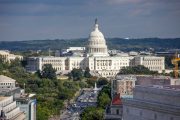
Federal employees earn, on average, 17 percent more in wages and benefits than their counterparts in the private sector, an April Congressional Budget Office (CBO) study concludes. What’s more, noted the CBO, the disparity in compensation is inversely proportional to employees’ level of education, with the most highly educated federal employees actually earning less than their private-sector counterparts.
The report, commissioned by House Oversight and Government Reform Committee Chairman Jason Chaffetz (R-Utah), compared the 2011 – 2015 wages and benefits of federal civilian employees and similar private-sector employees based on “individuals’ level of education, years of work experience, occupation, size of employer, geographic location (region of the country and urban or rural location), veteran status, and various demographic characteristics (age, sex, race, ethnicity, marital status, immigration status, and citizenship).”
When it comes to wages, the CBO found that federal workers with a high school education or less earn 34 percent more, on average, than similar private-sector workers. Those with a bachelor’s degree earn five percent more. But those with graduate degrees actually earn 24 percent less.
“Overall,” wrote the CBO, “the federal government would have reduced its spending on wages by 3 percent if it had decreased the pay of its less educated employees and increased the pay of its more educated employees to match the wages of their private-sector counterparts.”
The disparities are even more pronounced when it comes to benefits. Again, federal employees with no more than a high school diploma make out like bandits, getting a whopping 93 percent more in benefits than their private-sector counterparts, while those with a bachelor’s degree get 52 percent more. Those with professional degrees or doctorates get roughly the same benefits as their cohorts in the private sector. “On average for workers at all levels of education, the cost of benefits was 47 percent higher for federal civilian employees than for private-sector employees with certain similar observable characteristics,” according to the CBO.
The CBO fingered the “defined benefit pension plan” enjoyed by federal workers as “the most important factor contributing to differences” in benefits costs. While private companies have largely migrated to defined-contribution plans, in which employers and employees contribute to investment funds such as a 401(k) with no guarantee of a return, the government still guarantees its employees a certain level of income upon retirement.
According to a 2016 Heritage Foundation report, “On average, private employers who offer retirement plans typically contribute a maximum of between 3 percent and 5 percent of employees’ salaries to their retirement plan. The federal government’s retirement contribution — equaling between 15 percent and 18 percent of employees’ pay, depending on their year of hire — dwarfs that of private employers.”
The Federal Employees Health Benefits (FEHB) program is similarly both generous in its payouts and inexpensive for employees, with the government paying as much as 75 percent of premiums. In addition, retirees continue to be enrolled in FEHB and receive the same subsidy for the rest of their lives, which can be a long time considering the retirement age is only 57.
Federal employees get far more paid leave than private-sector employees: 33 days per year for a government employee with five years’ experience as opposed to 21 for a similar private-sector employee. Plus, the government gives its workers 10 holidays off.
The CBO found that total compensation, which includes both wages and benefits, for federal employees with a high school education or less outstripped that of their private-sector counterparts by 53 percent. For those with a bachelor’s degree, federal compensation was 21 percent higher. For those with graduate degrees, federal compensation was 18 percent lower. “Overall, the federal government paid 17 percent more in total compensation than it would have if average compensation had been comparable with that in the private sector,” concluded the CBO.
“Given these estimates, should it be presumed that those with high school or bachelors’ degrees are so much more productive and efficient in the government sector than in private enterprise that the salary and benefits discrepancy to their advantage reflects their net higher value to ‘society’?” asked economist Dr. Richard Eberling. “And should we presume that those employed by the federal government possessing those higher professional or doctorial [sic] degrees are really so much less valuable compared to those with similar education in the private sector?”
Both of those seem unlikely, although as Eberling pointed out, it’s impossible to know the value of a government employee because “the salary and benefits scales for government employees exist as semi-socialist islands of political decision-making that lack the same reasonableness, rationality or economic calculable efficiency as in the competitive private market process.” No one knows how much an Internal Revenue Service bureaucrat, for instance, should be earning because no comparable private-sector job exists, and the bureaucrat’s salary and benefits are funded by taxation, not voluntary spending.
It does seem reasonable to assume, however, that less-educated federal employees are being overcompensated. On the other hand, are those with graduate degrees being undercompensated? Perhaps not. It may be, observed Eberling, that they have opted for government employment despite the lower pay for various other reasons, including “the pleasure from socially engineering and controlling other people’s lives,” a lack of ability or expertise needed for private-sector success, or even “the difficulty of being fired for incompetence or subterfuge.” The CBO made note of that last motive in its report, stating, “Greater job security tends to decrease the compensation that the federal government needs to offer, relative to compensation in the private sector, to attract and retain highly qualified employees.”
Given that Washington spends $215 billion a year to compensate about 2.2 million civilian employees, what should be done about the obvious disparity between their compensation and that of their private-sector counterparts? The Heritage Foundation, in its report, recommended several changes to salary, benefits, hiring, and firing policies, all of which are certainly worth considering. However, as Eberling maintained, “There is no ‘fix’ for these wage, benefit and employment irrationalities and misallocations other than to radically reduce what the federal government does and the number of employees needed to do those more narrowly defined duties and responsibilities.” Anyone searching for the best guide to cutting Uncle Sam down to size need look no further than the U.S. Constitution.



